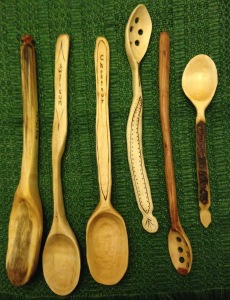 Six of my carved wooden spoons are now in new homes. A friend made a special order for Christmas gifts.
Six of my carved wooden spoons are now in new homes. A friend made a special order for Christmas gifts.
This order of gift spoons was a lot of fun to create and shows a range of wood and spoon styles.
The lilac spoon (second from right) was from a tree in Ontario, Canada. The spoon started out as a branch about 2” in diameter. With that size to work with, I was able to take care in carving to create a spoon with both heartwood (the darker wood) and sapwood.
This spoon became an olive spoon. The handle has to be long enough for the spoon to reach the bottom of the olive jar, and holes were carved in the bowl of the spoon to drain the olive juice.
I love olives, so I always enjoy making olive spoons. If my friend had not been interested in this spoon, I would have kept it for myself.

The birch spoon (below) is from a tree in Tennessee. The birch tree was cut in the winter. The time of year the tree is cut affects the wood. Because the sap isn’t flowing in the winter, the bark will stick to the wood and makes for an interesting spoon with a “bark handle”.
This spoon is one of three that I made from the birch branch. One spoon became a serving spoon, one became a cooking spoon, and one became an eating spoon.

The sweetgum came from a Gainesville, FL tree. A friend who is a runner often lets me know when she has spotted possible wood for my creative work when she is out running. She alerted me to a stack of sweetgum branches at the front of a yard awaiting the yard waste pickup truck. So I rescued a few branches.
I prepared the wood to become a spoon by cutting it in half and removing the pith. You can see the spoon’s beginnings in this blog post. I cut the branch into the length for spoons and then stored the wood in the freezer until I’m ready to carve the next stage of the spoons.

The two chestnut spoons below were from a tree growing in the backyard of the house where I grew up. The olive spoon handle twists, following the grain of the branch. By following the branch’s grain, the handle of the spoon is stronger than if I had just cut the shape with a saw.

The deep bowl of the second chestnut spoons makes it great as a serving spoon. I have a similar spoon that I also use as a stirring spoon.

The maple wood is from Gainesville, FL. I acquired this wood a few years ago. I was preparing for an art and crafts show and decided I needed some green (freshly cut) wood to use to demonstrate carving during the show.
Within just a few minutes of making that decision, I drove past a yard where a man was using a chain saw to cut a tree. I recognized the tree as a red maple and thought it would be great wood for my carving demonstration. I stopped my car and asked him if I could have some of the wood if I helped him cut the tree.
He agreed, and I wound up with several sections of the tree. To help keep the wood ready for carving, I placed the wood in water, and over time, some spalting developed in sections of the wood.
One of the pieces of the red maple I carved into a large stirring spoon, which has some interesting spalting.

It is always a joy to finish the carving of spoons and then feel how they become lighter in weight as they dry sitting on the kitchen counter. After about 3 days they are soaked in either food-safe walnut or food-safe tung oil. After a day of soaking, they then sit out to “drip dry” for a few days. Finally I finish them with beeswax, buff them, and send them to their destinations. With each spoon, I included directions on how to care for wood spoons to help make sure the spoons provide years of good service.
I’ve been carving spoons for a few years and enjoyed learning tips in a course I took at the Arrowmont School of Arts and Crafts on making kitchen items from wood. I’ve acquired what I believe are the best axes and carving knives for making spoons. I’ve even developed my philosophy about tools for carving spoons but as with many philosophies, I reserve the right to change and grow it as I continue carving spoons.
Very delightful design! Looks wonderful. Great artistic design
Thanks for sharing these creative wooden spoons! 🙂
LikeLiked by 1 person
Thank you! Happy and prosperous new year to you too!
LikeLiked by 1 person
Very nice work. I love the artisan look of these spoons. Have a happy new year and prosperous 2019.
LikeLike